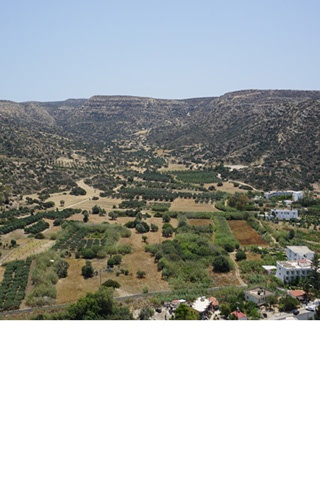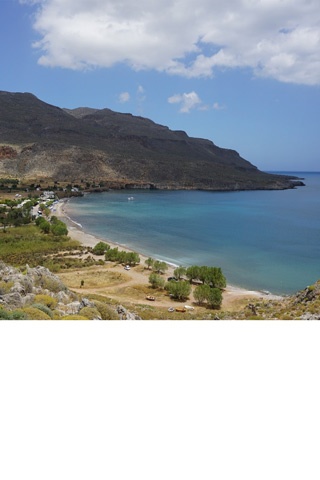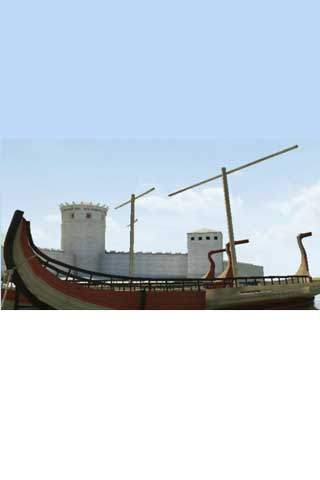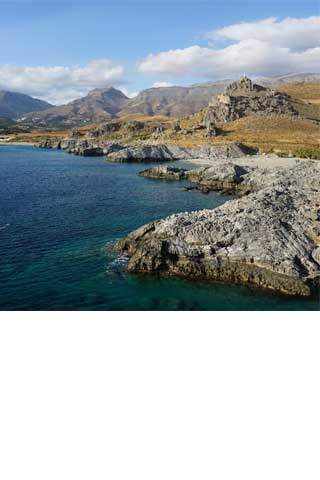15: Shallow Marine Miocene Carbonate Rocks around Matala
The fossil rich limestones were deposited on a shallow marine platform and reflect a transgressive sequence. Based on work by Kröger this guide shows how a section can be split up into facies types and used to define water conditions as well as for dating using fossils and Sr-Stratigraphy.
9: Variscan Basement lodged between Alpine Nappes, Mochlos to Chamezi
The area provides opportunity to study high grade metamorphic rocks such as mica shist, gneisses and amphibolites that have undergone several phases of deformation during the variscan orogeny. This guide also describes the prealpine basement cover as
well as andesite from the PQ-Unit.
10: Fragments of Prealpine rocks east of Sitia and Tyros Beds Vai Peninsula
Slivers of metamorphic Variscan rock crop out east of Sitia and at the Vai Peninsula. These were no doubt sheared off and transported during alpine nappe tectonics. Upper Triassic Tyros Beds are well exposed at the Vai Peninsula and have been classified by German and French geologists.
11: Tripolitza Nappe Thrust upon the Tyros Unit of Eastern Crete
Eastern Crete is a good place to study the Cretan Detachment Fault. A Tripoliza limestone nappe has been thrust onto the Upper Violet Slate of the Tyros Unit. Cataclastic rock and fault gouge accompanied by scaly cleavage occur within the shear zone indicating the forces at work.
12: Marine Terraces Miocene Corals and Tripoliza Flysch at Kato Zakros
Well developed marine terraces known for mammal fossil finds. The Kato Zarkos Gorge reveals a Miocene coral body and there is a thrust plane between Upper Violet Slates and a Tripolitza nappe. The Zarkos palace can be visited on the way to the beach
where there is Tripoliza Flysch.
13: Tripoliza Flysch and Pindos Nappe at Chametoulo
Slicken slides and cataclastites are sure signs of large normal faults. A road cut reveals a nicely developed flysch section overlain by Pindos limestone. Conglomerates, sandstone and silt beds display a classic fining up sequence. Trough crossbedding and greywacke are other typical features.
14: Siliclastic Continental Miocene Sedimentary Rocks South of Matala
The clastic rocks that crop out along the valley floors represent a former Miocene coastline with marshes, fresh water lakes and lagoons. In addition to silty clay deposits sections display finely laminated lacustrine limestone, lignite, gypsum crystals, and crossbedded delta sands and conglomerates.




Field guides
2: Mountain Building in Western Crete North and South of Sfinari
Folding of quartzite and phyllite strata and a second phase of brittle faulting indicate rock deformation at different levels within the earth’ crust. A nappe of Miocene rock on the Phyllite Quartzite unit indicates nappe tectonics.
3: Triassic Gypsum of the Phyllite Quartzite Unit in Western Crete
Highly deformed gypsum occurs together with rauhwacke within the Phyllite Quartzite unit. The evaporate rock is thought to have severed as a lubricant during nappe tectonics. However, the stratigraphic allocation of the gypsum is still controversial.
4: Western Crete, Stovles to Paleochora
Thick quartzite beds and siltstones have been offset by large faults containing fault gouge. A second location is a good example of the Cretan Detachment. A Tripoliza limestone nappe overlies the Phyllite Quartzite unit. Good examples of a tectonic thrust breccia.
5: Kalamos-Sequence of the Phyllite-Quartzite Unit in Western Crete
Impressive isoclinal folds within phyllite and aragonite rocks. The presents of aragonite is a sign of high pressure low temperature metamorphism and subsequent rash uplift. Fossils are not deformed in spite of folding and metamorphic conditions.
6: Holocene Reefs as Indicators of Sea Level Changes near Plakias
Marine organisms are important carbonate rock builders. This guide introduces some of the taxa and processes involved. A large Holocene reef is exposed along the coast revealing marine morphological features. Boulders of porphyritic volcanic rock are thought to have been deposited by a Tsunami.
1: Pleistocene to Holocene Crustal Movement, Phalasarna, Paleochora and Aradhena Gorge
Ancient uplifted harbor ruins destroyed by a tsunami and erosional notches as well as red algae crusts help to determine former sea level changes. Fine examples of carbonate sand dune rock and former marine terraces.
8: Neogene Sediments and Fossils Sita to Topula
The Aghia Fotia Beach is rich in Neogene marine fossils. Near by a Deinotherium was discovered. The scenic Toplua Gorge provides good examples of the Neogene Skopi Formation and Tafoni morphology. Miocene Corals can be found at a neighboring
marine Terrace.
7: Platy Marble Flysch and Triassic Gypsum, Mochlos to Kalavros
The Graben of Lastros is easily seen from a distance. To the north there is a huge gypsum quarry, which belongs to the Tripal unit. Close by are Quartz-Phyllite and Platy Marble rocks. Platy Marble Flysch crops out at Mochlos Beach and also appears on top of the magnificent Kalvaros cliffs further east.














